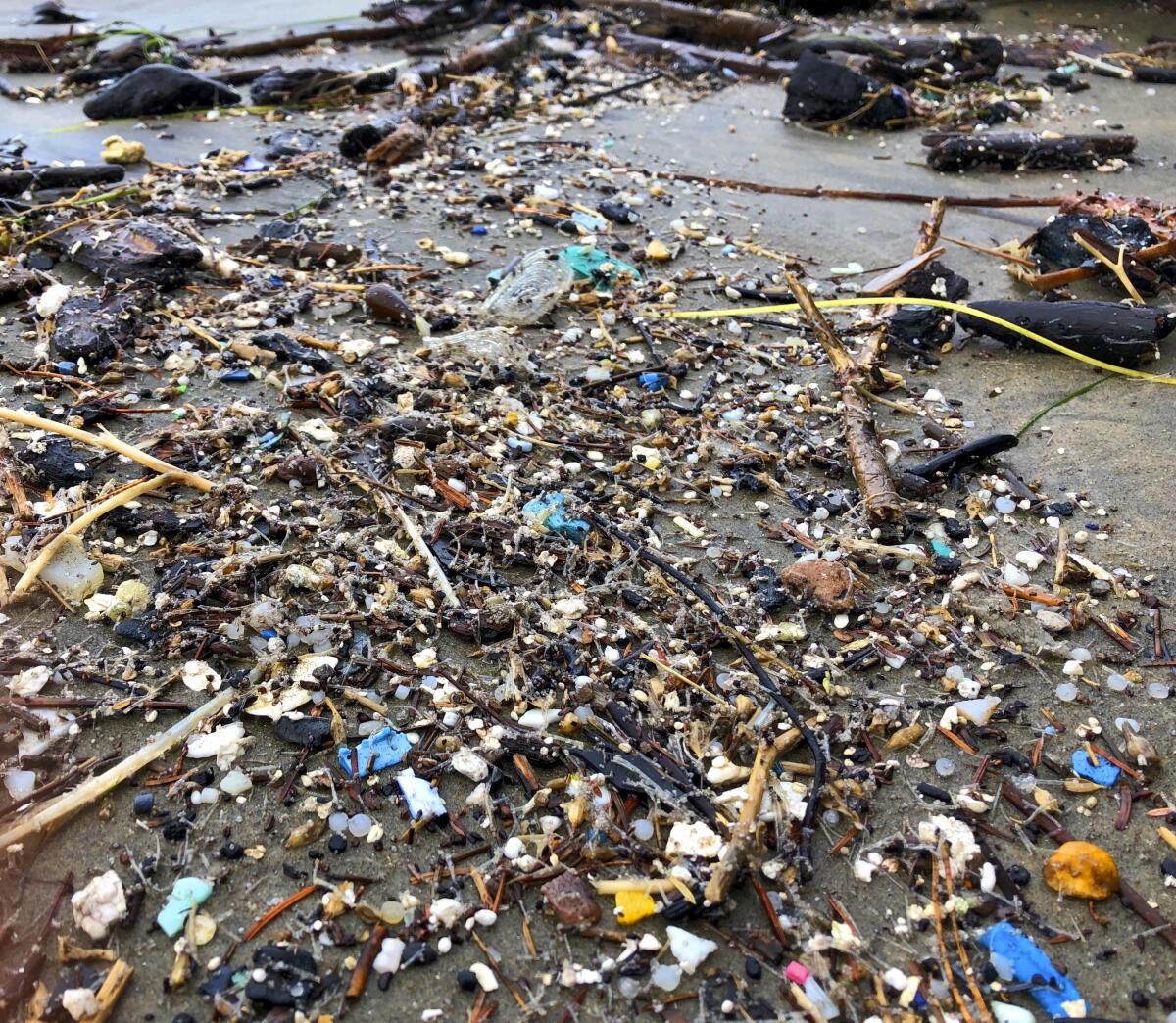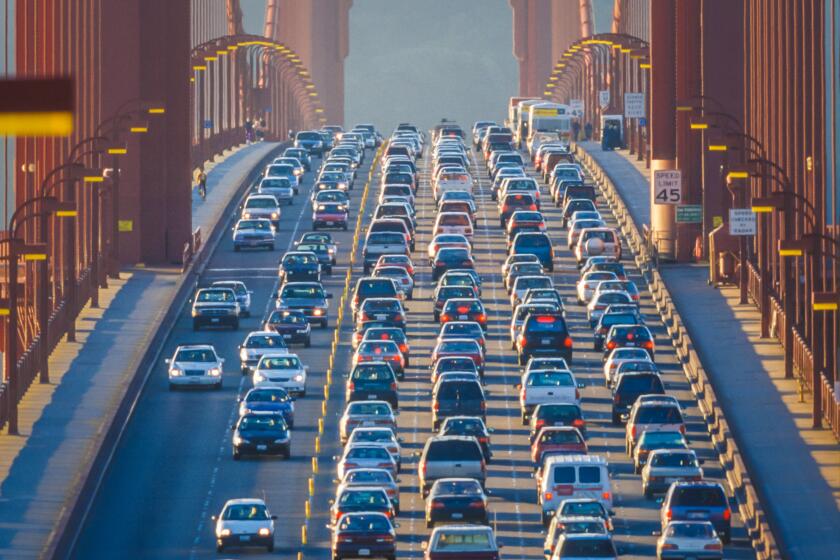California officials approve plan to crack down on microplastics polluting the ocean

- Share via
California aims to sharply limit the spiraling scourge of microplastics in the ocean, while urging more study of this threat to fish, marine mammals and potentially to humans, under a plan a state panel approved Wednesday.
The Ocean Protection Council voted to make California the first state to adopt a comprehensive plan to rein in the pollution, recommending everything from banning plastic-laden cigarette filters and polystyrene drinking cups to the construction of more green zones to filter plastics from stormwater before it spills into the sea.
The proposals in the report are only advisory, with approval from other agencies and the Legislature required to put many of the reforms into place. But the signaling of resolve from council members – including Controller Betty Yee and the heads of the Natural Resources and Environmental Protection agencies – puts California in the vanguard of a worldwide push on the issue.
“What this action says is that we have to deal immediately with what has become a global environmental catastrophe,” said Mark Gold, executive director of the Ocean Protection Council. “We are moving ahead, while we continue to learn more about the science.”
California Natural Resources Secretary Wade Crowfoot added: “By reducing pollution at its source, we safeguard the health of our rivers, wetlands and oceans, and protect all of the people and nature that depends on these waters.”
Industry opposition has helped kill legislation that would force single-use packaging to be recyclable or compostable. But voters will have a chance in November to impose those requirements with the California Recycling and Plastic Pollution Reduction Voter Act. The ballot measure would force single-use plastics to be reusable, recyclable or compostable, with the goal of cutting plastic waste by one-fourth by 2030. The measure would charge up to one cent per item to provide incentive to reduce waste, with the funds going to recycling and cleanup measures.
Scientists have estimated that 11 million metric tons of plastic spills into the ocean each year, an amount that could triple by 2040 without a course correction, the state’s report says.
Microplastics are commonly defined as particles smaller than 5 millimeters (about 3/16 of an inch) in diameter. Some come from the breakdown of plastic bags, bottles and wraps, others are derived from clothing fibers, fishing gear and containers.
A 2019 study of San Francisco Bay surprised some scientists when it concluded that the single largest source of microplastics was the tiny particles from vehicle tires that washed from streets into the bay.
The often invisible pollution has been found not only in the most remote oceans, but in seemingly pristine mountain streams, in farmland worldwide and “within human placentas, stool samples and lung tissue,” the state’s report noted.
Driving is not just an air pollution and climate change problem. Turns out, rubber particles from car tires might be the largest contributor of microplastics in California coastal waters, according to the most comprehensive study to date.
A wide variety of chemicals in the microplastics have been shown to harm fish and other sea creatures — inflaming tissue, stunting growth and harming reproduction.
The state’s plan outlined 22 actions to stem the problem, some designed to eliminate plastic waste at the source, others to cut off the waste before it gets into the air, storm drains and sewers and still others meant to enlighten the public about the problem.
Some of the proposals attack highly visible segments of the waste stream.
For years, environmental groups have routinely found microplastic-laden cigarette butts to be the most common form of trash in beach cleanups. The ocean protection agency suggested that California move this year to prohibit the sale and distribution of cigarette filters, electronic cigarettes, plastic cigar tips, and unrecyclable tobacco product packaging.
Similarly, the group recommended a ban on foodware and packaging made of polystyrene, which includes Styrofoam. It sets 2023 as a target date for that restriction.
The officials also recommended that state agencies use their own purchasing power to acquire reusable foodware whenever possible and to cut reliance on single-use utensils.
Other changes, already adopted, need to be put into place, like a 2021 law that requires restaurants to provide single-use utensils and condiments only when customers ask for them.
The state would also like to see manufacturers produce washing machines that filter out microfibers before they end up in storm drains. They would like vehicle tire makers to find alternatives that put less micro-waste on roadways. It’s unclear whether those changes will be mandated, or merely encouraged.
For plastics that are not reduced at the source, the ocean group recommended a number of measures to restrict the flow of microplastics into storm drains, streams and into the ocean. Those solutions sometimes come under the heading of “low-impact development” and include creation of trenches, greenways and “rain gardens” that filter and hold waste before it flows out to sea.
One woman’s crusade: a clean patch of beach
It also recommended placing more trash cans along beaches and other “hot spots,” where plastics can readily find their way into waterways.
While research about microplastic pollution has increased, there has not been a systematic approach or agreement on what pollutants should be measured. The ocean agency’s plan outlines shortcomings in the science that need to be corrected, so that pollution measures can be standardized and safety thresholds created.
Microplastic pollution has drawn international attention. The United Nations is attempting to draft a treaty to rein in the contaminants, while the European Union is drawing up a policy of its own.
The U.S. National Academies of Sciences, Engineering and Medicine reported last year that America produced more plastic pollution, through 2016, than any other country, exceeding all the European Union nations combined.
The California’s ocean agency’s action this week grew out of a 2018 law, authored by Sen. Anthony Portantino (D-La Canada Flintridge), that demanded state action.
Officials at the state Water Resources Control Board are working on a separate policy to measure and set safety guidelines for the levels of microplastics that will be permissible in drinking water.
The San Francisco Bay pollution study, co-authored by the San Francisco Estuary Institute, found that more than 7 trillion bits of plastic washed into the bay each year.
Warner Chabot, executive director of the institute, praised state leaders for approving the microplastics plan.
“Solving the problem requires that we stop or greatly reduce microplastics at their source,” Chabot said. “There is no quick fix and a range of options for a solution.”
More to Read
Sign up for Essential California
The most important California stories and recommendations in your inbox every morning.
You may occasionally receive promotional content from the Los Angeles Times.












